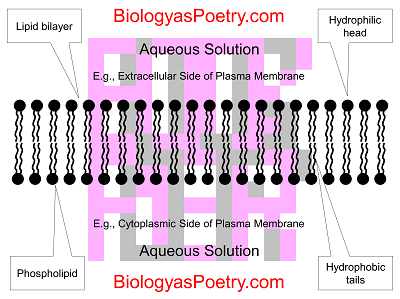∞ generated and posted on 2016.08.24 ∞
Those selectively permeable, multimolecular structures that are the predominant constituent of cell membranes.
Lipid bilayers in most organisms consist of phospholipids and are permeable especially to small, nonpolar substances. Compare with fluid mosaic model of cell membranes.

Figure legend: Schematic representation of a lipid bilayer consisting of phospholipids. Note the arrangement of these lipids with hydrophilic heads facing outward towards the surrounding aqueous solution(s) while the hydrophobic tails of these phospholipids face inward towards each other.
Lipid bilayers furthermore are sided, with the membrane surrounding cells having a side that faces the interior of the cell (cytoplasm) along with a side that faces the world outside of the cell. This sidedness, in membranes, is crucially important to the functioning of cells since it determines, for example, which direction substances are pumped across membranes, such as into cells versus out of cells.
The following is a list of terms associated with lipid bilayers:
Active transport, Cholesterol, Electrochemical gradient, Facilitated diffusion, Flip flopping, Integral membrane protein, Lipid bilayer, Lipopolysaccharide (LSP), Membrane potential, Membrane protein, Passive diffusion, Passive transport, Phospholipid, Peripheral membrane protein, Proton pump, Selective permeability, Transmembrane protein, Transport protein